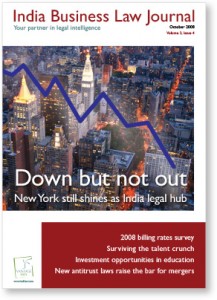It’s the year of living dangerously. And no time for schadenfreude and crowing over the mistakes of others. A falling tide lowers all boats
Lax oversight and uneven enforcement are hardly the sole prerogative of Western financial systems. True, as one commentator puts it, unfettered capitalism has given way to unbridled panic. At the same time, policy responses seemingly unthinkable just a month ago (wholesale nationalization of the financial sector, tidal wave-like injections of liquidity and more) have become conventional wisdom overnight.
What does this mean for in-house practitioners, law firms serving Indian and international corporates and other India watchers around the world?

India Business Law Journal
It’s early days, of course, but the chill of the global credit freeze seems a long way from the shores of the mainstream Indian economy. In our Cover story this month, we look at the financial crisis through the eyes of India-focused lawyers in New York. Far from being on their knees, they are busy and cautiously optimistic (page 17). A rosy picture of a growing international centre for India-related legal work emerges. Some observers even speculate that New York may challenge London’s preeminence in this arena.
As the saying goes, when one door closes, two others open. The ongoing financial tumult can offer opportunities for the fleet of foot. As this issue of India Business Law Journal was going to press, Tata Consultancy Services was reportedly purchasing the outsourcing units of struggling North American banks.
Closer to home, new regulatory hurdles, rising costs and recruitment challenges are arguably having a greater impact than the financial meltdown on the lives of legal professionals.
One of this issue’s Spotlight features (Raising the bar for M&A, page 32) tracks the emergence of new competition legislation across Asia that is forcing companies to rethink their strategies for mergers and acquisitions. Businesses looking to expand locally and internationally are likely to be impacted by a wide range of pre-merger notification requirements.
India is expected to implement its new antitrust framework early next year. China introduced a similar regime in August and Hong Kong’s new competition law is on the drawing board. The result, it seems, is that Asia’s regulatory map for merger approvals is set to become significantly more complex. Some observers speculate that the increased cost, uncertainty and complexity of obtaining the necessary permissions may become a deterrent to M&A deals.
Indian and international law firms are set to be the principal beneficiaries of the emerging laws. Many are already establishing new competition practices in the region and strengthening their teams in anticipation.
Another development that is keeping law firms busy is the sudden emergence of India’s private education market (Back to school, page 39). Government liberalizations have transformed this once-staid sector into a US$40 billion market, ripe for private investment. Despite the industry being fraught with regulatory restrictions, local and international investors, with the help of innovative legal strategies, are beginning to play a part in the country’s “education revolution”.
The transformation of the education sector is just one example of the growth that is putting Indian lawyers in greater demand than ever before. And it’s not just local law firms that are competing for talent. Outsourcing companies and expanding in-house legal departments are depriving Indian law firms of new blood. The already-thin “middle rung” is becoming increasingly conspicuous by its absence in many such firms. Meanwhile, international law firms are “stockpiling” Indian lawyers, preparing for the day the market is open to them.
How to recruit, train and retain just such practitioners has been an oft-repeated concern in these pages. This month’s extensive coverage (Surviving the talent crunch, page 26) investigates this vital subject in depth, and reaches important conclusions.
The spiralling demand for Indian lawyers may be interpreted by some as a sign that India will escape the worst of the current financial turmoil. But this is no time to be complacent.
Writing in this month’s Vantage point (page 16), Jamie Allen, secretary general of the Asian Corporate Governance Association, exposes serious corporate governance flaws that lurk beneath the surface of many Indian corporations. The current economic troubles, he says, will bring these cracks to the surface unless immediate action is taken to remedy the situation.
Allen urges Indian law firms to lead the charge. However, he warns that before they can do so, they must adopt best-practice standards of governance and transparency in the running of their own practices. With this in mind, Allen applauds the initiative taken by 33 Indian law firms to publish their hourly billing rates with “openness and transparency” in this issue of India Business Law Journal (Intelligence report, page 43).
Since the billing rates survey was first conducted last year, the number of participating firms has jumped by 32%. Our coverage reveals that the average hourly fee for an Indian corporate lawyer is now US$192, up from US$180 last year.
Perhaps more revealing than the figures is the fact that a growing number of Indian firms are responding to client demands and committing to fair and transparent billing practices. In the words of one corporate counsel: “I would definitely be more likely to use one of the law firms that has revealed its rates in this survey than any of those that haven’t.”



























